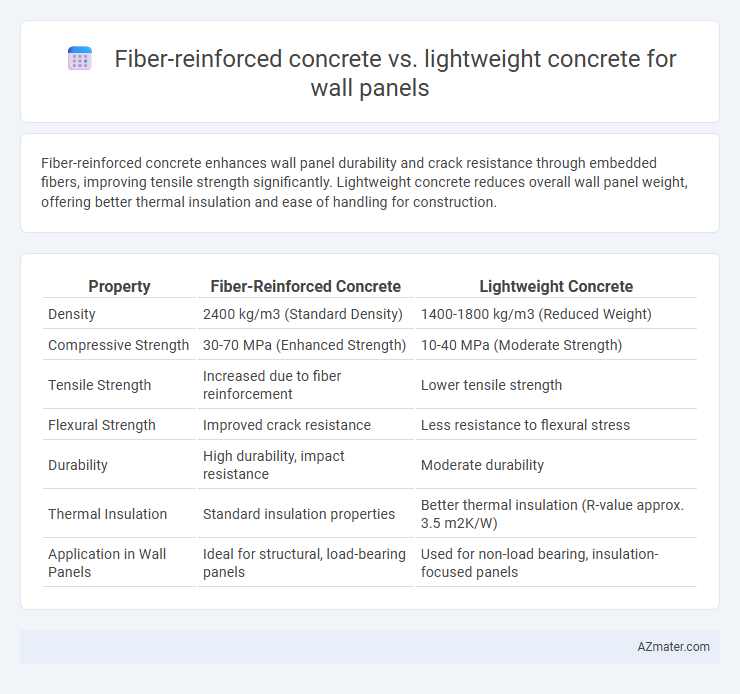Fiber-reinforced concrete enhances wall panel durability and crack resistance through embedded fibers, improving tensile strength significantly. Lightweight concrete reduces overall wall panel weight, offering better thermal insulation and ease of handling for construction.
Table of Comparison
| Property | Fiber-Reinforced Concrete | Lightweight Concrete |
|---|---|---|
| Density | 2400 kg/m3 (Standard Density) | 1400-1800 kg/m3 (Reduced Weight) |
| Compressive Strength | 30-70 MPa (Enhanced Strength) | 10-40 MPa (Moderate Strength) |
| Tensile Strength | Increased due to fiber reinforcement | Lower tensile strength |
| Flexural Strength | Improved crack resistance | Less resistance to flexural stress |
| Durability | High durability, impact resistance | Moderate durability |
| Thermal Insulation | Standard insulation properties | Better thermal insulation (R-value approx. 3.5 m2K/W) |
| Application in Wall Panels | Ideal for structural, load-bearing panels | Used for non-load bearing, insulation-focused panels |
Introduction to Fiber-Reinforced and Lightweight Concrete
Fiber-reinforced concrete incorporates fine steel, glass, or synthetic fibers to enhance tensile strength and crack resistance, making it ideal for structural wall panels requiring durability and impact resistance. Lightweight concrete, typically produced using expanded clay, shale, or foam, offers reduced density and improved thermal insulation, which benefits energy-efficient wall panels. Both materials optimize different performance aspects, with fiber-reinforced concrete emphasizing mechanical strength and lightweight concrete focusing on weight reduction and thermal performance.
Key Properties of Fiber-Reinforced Concrete
Fiber-reinforced concrete (FRC) enhances tensile strength, toughness, and crack resistance in wall panels by embedding synthetic or steel fibers within the cement matrix, improving durability under dynamic loads and impact. Unlike lightweight concrete, which prioritizes reduced density and thermal insulation, FRC provides superior flexural strength and fracture toughness, crucial for structural integrity and long-term performance. The key properties of FRC include increased energy absorption capacity, improved post-crack behavior, and enhanced resistance to shrinkage and fatigue, making it ideal for high-stress wall panel applications.
Key Properties of Lightweight Concrete
Lightweight concrete for wall panels exhibits reduced density ranging from 1,200 to 1,800 kg/m3, significantly enhancing structural efficiency and thermal insulation compared to standard concrete. Its high porosity contributes to improved fire resistance and sound absorption, making it ideal for energy-efficient buildings. While fiber-reinforced concrete offers superior tensile strength and crack resistance, lightweight concrete excels in reducing dead load and improving thermal performance in wall panel applications.
Strength Comparison: Fiber-Reinforced vs Lightweight Concrete
Fiber-reinforced concrete exhibits superior tensile strength and crack resistance compared to lightweight concrete, making it ideal for wall panels requiring enhanced durability. The inclusion of fibers, such as steel or synthetic materials, significantly improves the mechanical properties and impact resistance of the concrete matrix. Lightweight concrete, while beneficial for reducing structural load, generally has lower compressive and flexural strength, limiting its use in applications demanding high structural performance.
Durability and Longevity Factors
Fiber-reinforced concrete (FRC) enhances wall panel durability by improving crack resistance, impact strength, and fatigue life, making it ideal for structures exposed to dynamic loads and harsh environments. Lightweight concrete offers benefits like reduced structural weight and thermal insulation but typically has lower compressive strength and higher permeability, which can affect long-term durability under freeze-thaw cycles and moisture exposure. For longevity, FRC panels demonstrate superior resistance to environmental stressors and reduced maintenance needs, whereas lightweight concrete panels require protective coatings or additives to improve their durability performance.
Thermal and Acoustic Performance
Fiber-reinforced concrete enhances wall panel durability and crack resistance while offering moderate thermal insulation due to its dense matrix, but its acoustic performance is typically superior in impact noise reduction. Lightweight concrete wall panels provide significantly better thermal insulation with lower thermal conductivity values ranging from 0.1 to 0.3 W/m*K, improving energy efficiency in buildings, and also excel in acoustic absorption, effectively reducing airborne noise transmission. Choosing between the two depends on balancing structural requirements and desired thermal and acoustic properties for optimized building envelope performance.
Installation and Handling Considerations
Fiber-reinforced concrete offers enhanced tensile strength and crack resistance, making wall panels easier to handle during installation with reduced risk of damage or breakage. Lightweight concrete provides improved thermal insulation and significantly reduced panel weight, facilitating faster lifting and positioning but may require more care to avoid surface chipping. Both materials demand specialized tools and skilled labor for cutting and fastening, yet fiber-reinforced concrete panels generally allow for greater flexibility in handling due to their durability.
Cost Analysis and Economic Viability
Fiber-reinforced concrete (FRC) for wall panels typically incurs higher initial material costs due to the inclusion of synthetic or steel fibers, but it offers enhanced durability and reduced maintenance expenses over time. Lightweight concrete panels present lower material and transportation costs owing to their reduced density, contributing to savings in structural support and installation labor. Evaluating overall economic viability requires balancing upfront investment in FRC against long-term performance benefits, whereas lightweight concrete emphasizes budget-friendly immediate costs with potential trade-offs in strength and longevity.
Environmental Impact and Sustainability
Fiber-reinforced concrete (FRC) reduces cracking and enhances durability, extending the lifespan of wall panels and decreasing the need for frequent repairs and replacements, thereby lowering environmental impact. Lightweight concrete uses less raw material and improves insulation, contributing to energy efficiency and reducing carbon footprint throughout the building's lifecycle. Both materials offer sustainable benefits, but fiber-reinforced concrete's longevity and structural performance often result in greater overall environmental savings compared to lightweight concrete.
Best Applications and Project Suitability
Fiber-reinforced concrete excels in wall panels requiring enhanced tensile strength, impact resistance, and crack control, making it ideal for industrial buildings, seismic zones, and heavy-duty structures. Lightweight concrete is best suited for applications needing reduced dead load, improved thermal insulation, and sound absorption, such as residential buildings, high-rise construction, and prefabricated panels. Project suitability depends on structural demands, with fiber-reinforced concrete preferred for durability under stress and lightweight concrete favored for energy efficiency and ease of handling.

Infographic: Fiber-reinforced concrete vs Lightweight concrete for Wall panel
 azmater.com
azmater.com